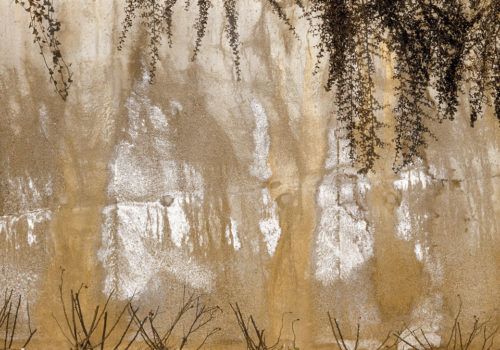Lastly, Les Photographiques will present the work of four other photographers: Francis Jalain’s “Mémoires,” Michel Lagarde’s self-portraits in a series entitled “Dramagraphies,” Christophe Salles on his photographs of cities, and an Yves Allain.
Francis Jalain – Mémoires
This series of photographs taken between 1980 and 2008 are part of an approach which offers a different meaning and interpretation of the elements that surround us. The aspect of a virtual landscape at first glance transforms itself into the perception of the photography of a wall. I only take a picture once I have perceived a “landscape” on a wall’s surface.
Photographed with a large frame, these walls reappear like landscapes when cropped. These photographs conjure the space in our minds where the vague memories of travels are inscribed. The imaginary places and the rhythms of nature mingle as in a dream. The focal point of these images is in the confrontation between the virtual and the real. They remind us of the work of certain modern and abstract painters.
Michel Lagarde – Dramagraphies
Michael first showed me his work years ago. He only had a dozen images. This will give you an idea of the gestation period for each one. I remember very well the first shock I felt before these large-format prints, where the eye met an even depth of field. I mentioned it to him, telling him, “It wasn’t like that in real life,” to which he responded that it was indeed. He was right, of course. Look around you. No matter where your eyes look, it’s clear. These are the optical limits of the camera, which has gotten us used to blurred backgrounds.
In fact, each image was overrun with life, each detail its own center of attention, without detracting from the principal themes of the image. That’s the reward for impeccable composition, where our look is directed exactly where the painter (you’ll see) wishes… I understood that even if Michel had stopped using acrylics and oils years before, he had really never stopped painting. I felt that, looking at this photographs, I was standing before one of his paintings, except that he had painted it with a lens instead of a brush. The term “Self-Portrait” was inadequate to describe these worlds, hence the word “Dramagraphie”. It was our theatrical world laid out before us by the painter’s eye. Behind those characters and scenes was a sly dramaturgy hiding in the viewer’s imagination. Who, why, where and when, yes, but for goodness sake when? Everything was possible in each story. It was the spectator who did the work. In each image, the comedic force broke out with kindness and simplicity, and yet each one functioned like those vanitas paintings from the 16th and 17th centuries.
Text by Patrick Mecucci for the book Dramagraphies published by Editions Ankama
Christophe Salles – Villes
The city is inside. It lacks form but is rich in images from cinema, photography, television and comics. Overwhelmed by conventions, the only choice left is to throw them off and have fun, the way Christophe Salles does in his decomposed and recomposed photographs. He plays with the setting, with the viewer’s perspective, with the images themselves. The photographs of Christophe Salle play while playing out. Against an immaculate blue sky, a steel building reminds viewers of the openning credits in Dallas the TV series. In a grim twilight, a patch of parking on a Manhattan rooftop, a stalled car—it’s a scene from a Scorsese film. Smoking towers evoking September 11. Christophe Salles loves to play with the recognition and reminiscences of cliché. But up close, we see that it’s a bric-à-brac world pieced together from backyard junk, touched by a ray of setting sunlight. Through these photographs, all the imagery of the city finds itself at a distance.
Bruno Dubreuil / Galerie Immix-Paris
Yves Allain- Rétrospective
Yves Alain loves to relate a childhood memory: wanting to start a career in photography and cinema, he got in touch with someone in the industry and shared his dream: to go to film or photography school. The person responded: “ Study medicine first, you’ll make your parents happy, and you can always do cinema or photography afterwards.” The young man followed this advice, but never left behind his childhood dreams: watercolors, drawing, photography and cinema were passions throughout his life.
















